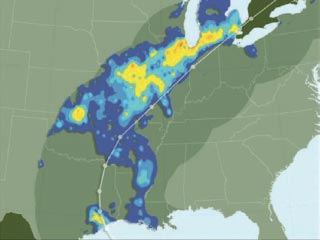UI researchers find East Coast hurricanes can flood the Midwest

The flood ratio map for Hurricane Ike (2008) shows areas in yellow and orange that approach or exceed 10-year flood peaks at their respective stream gauge stations.© 2014 American Meteorological Society.
Located hundreds of miles inland from the nearest ocean, the Midwest is unaffected by North Atlantic hurricanes.
Or is it?
With the Nov. 30 end of the 2014 hurricane season just weeks away, a University of Iowa researcher and his colleagues have found that North Atlantic tropical cyclones in fact have a significant effect on the Midwest. Their research appears in the Bulletin of the American Meteorological Society.
Flood ratio map of the midwest from Hurrican Ike
The flood ratio map for Hurricane Ike (2008) shows areas in yellow and orange that approach or exceed 10-year flood peaks at their respective stream gauge stations.© 2014 American Meteorological Society.
Gabriele Villarini, UI assistant professor of civil and environmental engineering, studied the discharge records collected at 3,090 U.S. Geological Survey (USGS) stream gauge stations from 1981 to 2011 and found that the effects of North Atlantic tropical cyclones impact large areas of the United States away from Florida, the East Coast and the Gulf Coast.
“When you hear about hurricanes or tropical cyclones you think about storm surges and wind damage near the coast,” says Villarini, who also conducts research at the internationally renowned IIHR-Hydroscience & Engineering. “But it’s much more than that. Flooding from a single tropical cyclone often impacts 10 to 15 states located hundreds of miles from the coast and covering a wide area.
“Our results indicate that flooding from tropical cyclones affects large areas of the United States and the Midwest, as far inland as Illinois, Wisconsin, and Michigan,” says Villarini.
“The USGS stream gauges, located east of the Rocky Mountains, showed that tropical cyclones can cause major flooding over the Midwest, including the southeastern corner of Iowa,” he says.
Villarini and his colleagues conducted their study by relating maximum water discharges recorded by USGS stream gauges with the passage of the storms over the Midwest and eastern states. Accordingly, they were able to construct maps for each storm that show the relationship between inland flooding and tropical cyclones.
Despite these important impacts, inland tropical cyclone flooding has received little attention in the scientific literature, although the news media have begun to pay more attention following Hurricane Irene in 2011 and Hurricane Sandy in 2012, he says.
Villarini says that the amount of financial damage caused by the storms in the Midwest and the eastern United States will be the subject of a future study.
Villarini’s colleagues are Radoslaw Goska of the UI'sIIHR-Hydroscience& Engineering, James Smith of Princeton University, and Gabriel Vecchi of the National Oceanic and Atmospheric Administration’s Geophysical Fluid Dynamics Laboratory in Princeton, New Jersey.
The paper, titled “North Atlantic Tropical Cyclones and U.S. Flooding,” can be found in the Bulletin of the American Meteorological Society at journals.ametsoc.org/doi/abs/10.1175/BAMS-D-13-00060.1.
Funding for Villarini and Goska was provided by the Iowa Flood Center and IIHR-Hydroscience & Engineering. Villarini also notes support from the U.S. Army Corps of Engineers Institute for Water Resources. James Smith received funding from the Willis Research Network and the NOAA Cooperative Institute for Climate Sciences.
Contacts
Gabriele Villarini, Department of Civil and Environmental Engineering, 319-384-0596
Gary Galluzzo, Strategic Communications, 319-384-0009
Media Contact
All latest news from the category: Earth Sciences
Earth Sciences (also referred to as Geosciences), which deals with basic issues surrounding our planet, plays a vital role in the area of energy and raw materials supply.
Earth Sciences comprises subjects such as geology, geography, geological informatics, paleontology, mineralogy, petrography, crystallography, geophysics, geodesy, glaciology, cartography, photogrammetry, meteorology and seismology, early-warning systems, earthquake research and polar research.
Newest articles

Making diamonds at ambient pressure
Scientists develop novel liquid metal alloy system to synthesize diamond under moderate conditions. Did you know that 99% of synthetic diamonds are currently produced using high-pressure and high-temperature (HPHT) methods?[2]…

Eruption of mega-magnetic star lights up nearby galaxy
Thanks to ESA satellites, an international team including UNIGE researchers has detected a giant eruption coming from a magnetar, an extremely magnetic neutron star. While ESA’s satellite INTEGRAL was observing…

Solving the riddle of the sphingolipids in coronary artery disease
Weill Cornell Medicine investigators have uncovered a way to unleash in blood vessels the protective effects of a type of fat-related molecule known as a sphingolipid, suggesting a promising new…





















